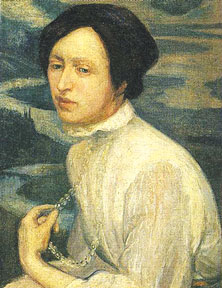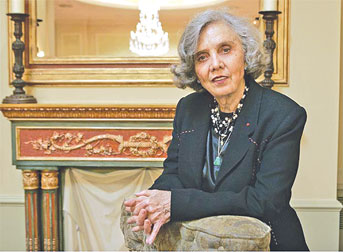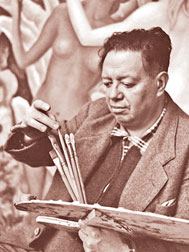|
Querido Diego: Te abrazo quierla:
A post-Boom testimonial novel by Elena Poniatowska

 |
|
Portrait of Angelina
Beloff by Rivera |
Elena Poniatowska falls into the category of a post-Boom novelist.
She was born on May 19, 1933 in Paris, France. Her father was French of
Polish ancestry and her mother a Mexican who was raised in France. When
she was nine, Poniatowska's family moved to Mexico City. She grew up
speaking French and learned English in a private British school.
However, her knowledge of Spanish came from talking with the maids, so
her written Spanish is largely colloquial. Poniatowska developed ties
with the Mexican lower class in her youth and thus gained a sense of
belonging to and an understanding of Mexican culture. She felt and
thought of herself as completely Mexican and of Spanish as her native
language. Her works include characters who belong to the underprivileged
classes, and she often gave voice to the powerless of her country.
Ponistowska's skill as a novelist was her ability to combine fact
with fiction. She lent her voice to the voiceless, but at the same time
she took a step back and let the victims come forward to express their
needs and pain, letting the Mexican people speak through her. Her
settings were mostly in Mexico, and her characters were either Mexicans
or people such as Angelina Beloff (Querido Diego, te abraza Quiela) or
Tina Modotti (Tinísima) who spent significant parts of their lives in
Mexico (Tina Modotti was one of Diego Rivera's models). Many of her
female characters are at the mercy of men. Their lives are ruled by a
world made up of double standards. They try to do the right thing, but
in the end they lose the men they loved and for whom they sacrificed.
Querido Diego is a testimonial work of fiction in the Latin American
tradition of the post-Boom novela testimonio (testimonial novel)
developed by the Cuban author Miguel Barnet with his famous 'Biografía
de un cimarrón'
The novel consists of twelve letters, supposedly written by the
Russian/Mexican painter Angelina Beloff (Quiela) to Diego Rivera. Beloff
writes from Paris, alone and abandoned after Rivera's departure and
return to Mexico after living with her for ten years. Rivera had
returned alone to Mexico, since the two lovers can only afford one
ticket. Rivera promises to send for Quiela at a later date. He writes
her brief, emotionally detached letters for a short time and then stops
writing all together, continuing to send only occasional money orders.
At the time of Quierla's first letter, she hasn't heard from Diego for
some time but remains hopeful that he still loves her and that they will
be reunited in Mexico. She writes, reaffirming her love for him and
asking for reassurance of his love for her. She recalls shared
experiences and informs him of her daily activities and sends him prints
of the etchings that she has been commissioned to do.
Thematically Quierla's letters represent a transparent effort on the
part of the woman to recreate her relationship with Diego. She tries to
restore this through a written recollection of shared experiences and
time spent together. Included in this are references to their dead son,
who she refers to as Dieguito, their first meeting and their joint
artistic ventures. As well as reminding Diego of shared experiences,
Quiela's discourse about their life together serves to join the first
person 'I'/me' and the second person 'you' into the first person plural
'we/us'. Additionally the letters contain recurring questions and
appeals. They are requests intended to elicit responses and actions, to
establish a dialogue and some communication between the writer and the
recipient. These written questions are not simply aimed at eliciting a
response but in particular, a written response. Quierla repeatedly asks
for 'a line from you'. The dialogue that Quiela yearns for is written
communication, not verbal or physical contact.
By its very nature, a question implies the desire for and the
possibility of an answer, of reciprocal communication. Also, letters, by
their very nature, imply the absence of the recipient. They are of
course, sent to a person who is not in the presence of the writer. In
this novel, the letters to a silent other signify a couple of things.
 |
|
Elena Poniatowska |
Firstly, they imply the existence and the absence of another.
Secondly, the desire signifies the absence of its object. Diego
functions as the absent object of both the discourse and of Quiela's
desire. Not only do the letters present a play between the presence and
the absence of the object, they also suggest a similar ambivalence with
regard to the narrator, who is the subject. The written word is able to
'act' independently of the author. The fact that we are reading letters
rather than hearing speech suggests distance between the writer and her
words and the absence of the writer from us. These particular written
words are especially distanced from the writer herself. Although
Quiela's native language is Russian, she is writing in Spanish in order
to communicate with Diego. The fact that she is using a foreign language
to communicate with him implies a surrender of her identity and her
authentic self and of total identification with Diego. She has had to
abandon her own words and relies on the native words of another.
Conversely the function of Quiela's etchings is totally different
from that of her written words. While the writing constitutes her
attempt to recover her relationship with Diego, the etchings
unintentionally help her to recover her relationship with herself and to
rediscover her own identity.
Over the course of their relationship, Quiela totally surrendered
herself to Diego. No only did she adopt his language but she also gave
up her own career as an artist. She spent her time washing Diego's paint
brushes and preparing his canvases. Even the birth of her son did
nothing to change her priorities; he was named after Diego and Quiela
confesses that she always valued her lover over her baby.
Quiela expresses her changing attitude towards her lost life and dead
child as she contrasts her early years in art school with her present
situation. She recalls seeing children on the street during her younger
years and thinking of them as models, shapes and forms to be
incorporated in her artwork. After the death of her son and Diego's
departure, he perception undergoes a change. She now looks at children
and sadly remembers her own lost child.
Her new perception stems from her own loss and the absence of her son
raises her awareness of the presence of other children. This now leads
to her drawing children; this is the only way she can recapture her son
and express her feelings about him. These etchings enable Quiela to
recreate and love her son as they represent her child literally and
symbolically. This time though, Diego is excluded from the creation of
the child; these artistic creations are Quiela's alone.
Not only do the etchings represent Quiela's changing attitude but
they seem to be the vehicle for her transformation. It is through this
creative outlet that Quiela begins to recover the self that she had
surrendered to Diego. However, she reports in one of her letters that
she felt that Diego's spirit had taken control of her. She thinks of
Angelina as a third person who she would care for, as one would care for
his or her lover.
It seems that she has given so much of herself over to Diego that it
is only by briefly becoming him that she can become herself . One night,
the sensation that Diego has taken over her spirit spills over into the
belief that he is the source of her intense desire to paint. However,
her attempt to become one with Rivera and to paint as he paints does not
work out. Quiela becomes seriously ill and cannot continue painting.
 |
|
Diego Rivera |
Eventually, she recovers sufficiently to seek well-paid employment.
Yet instead she returns to her etchings, since she derives a greater
level of self-worth and satisfaction from them. In Quiela's last letter,
the tone changes completely. She writes to Rivera for the last time and
tells him about her already finished illustrations for the Parisian
magazine Floreal. Her artistic work is done and she has recovered with
dignity.
On one level, the narrative is about one woman in love with someone
who does not want her. Yet in the end it is about the aesthetic process
of painting without the influence of her lover, a process that
eventually makes Quiela a new woman and enables her to get on with her
own life. The short concluding narrative describes Quiela's trip to
Mexico in 1935, thirteen years after she has stopped writing. She does
not look for Rivera, but bumps into him at a theatre in Mexico City.
He does not recognize her and this can be interpreted in two ways:
Either Rivera has forgotten her to the point that he does not even
recognize her. Alternatively the woman he sees is no longer the
heartbroken lover but a new Angelina Beloff, an artist who has her own
life and art and who does not need him anymore.
The novel is essentially a feminist discourse about the oppression
that women live under when they love too much. Pontiatowska once again
lends her voice to oppressed, (although Quierla and women like her may
be in that situation through their own doing). However, through Querido
Diego te abrazo Quiela, Pontiatowska also offers such women real hope of
recovering themselves and moving on.
|

